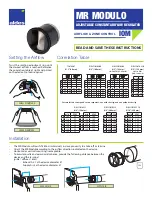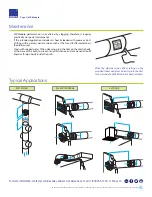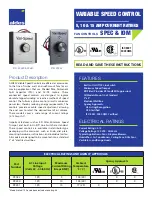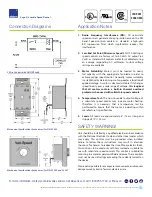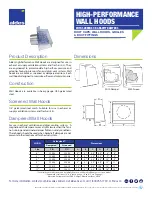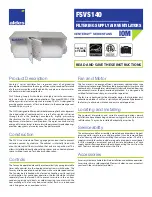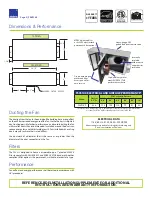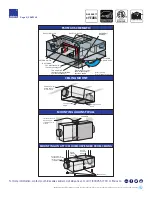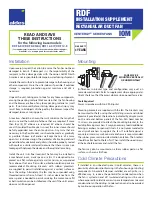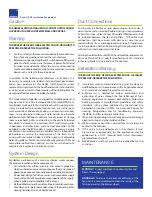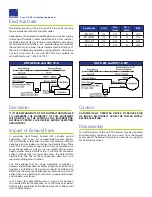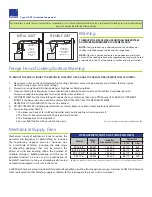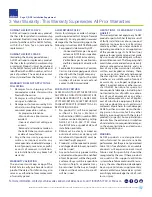
Mechanical Supply Fans
Mechanical supply of outdoor air tends to reduce the
potential and frequency of backdrafting by reducing
the contributing negative pressures; however, due
to a multitude of factors, including the wide range
of exhausting appliances that may be present, the
effects of wind and building shape, the presence of
multiple chimneys, building leakage, and the use of
operable windows, no one can assure elimination of
backdraft conditions so long as atmospherically vented
combustion equipment is present in the home.
ALDES North America accepts no liability for backdraft conditions resulting from negative pressures. Nor does ALDES North America
make representation that blending supply ventilators (BVS) are adequate to prevent such occurrences.
REPLACEMENT PARTS LIST (BASE MODELS)
Model
Motor
P/N
Impeller
Dimensions (mm)
Capacitor
P/N
Cap
RDF 8-8IP*
86 561
133 x 42
86 172
4uF
RDF 8-8 MAX
86 561
133 x 45
86 172
4uF
RDF 12-8IP*
86 562
180 x 35
86 179
10uF
RDF 12-8
86 562
180 x 35
86 170
5uF
*Designates Impedance Protection with alternate wiring of capacitor across auxiliary winding of motor.
Page 4 | RDF Installation Supplement
METAL DUCT
RDF
RDF
FLEXIBLE DUCT
CEILING
GRILLE
WITHIN 30"
OF COOK
SURFACE USE
METAL DUCT
ONLY
FLEXIBLE DUCT
ACCEPTABLE
OR AS REQUIRED
BY LOCAL
BUILDING CODE
30"
CEILING
OVER
30"
For installations in which the fan is connected to a range hood, or if an exhaust grille connected to the fan is located near the cooking surface (as shown below),
be sure to observe the following safety warnings:
Warning
TO REDUCE THE RISK OF FIRE, USE ONLY GALVANIZED STEEL
DUCTWORK WHEN REQUIRED TO USE METAL DUCT.
NOTE:
If only rigid ducting is allowed, a metal sound attenuator
shall be installed between the fan and the range hood.
NOTE:
If the fan is not connected to a range hood or a grille in the
vicinity of the cooking surface, other approved ducting may be used
as described in the “Duct Connections” section of basic instructions.
Range Hood/Cooking Surface Warning
TO REDUCE THE RISK OF INJURY TO PERSONS IN THE EVENT OF A RANGE-TOP GREASE FIRE, OBSERVE THE FOLLOWING:
1.
Never leave surface units unattended at high settings. Boilovers cause smoking and greasy spillovers that may ignite.
Heat oils slowly on low or medium settings.
2.
Always turn range hood ON when cooking at high heat or flambeing food.
3.
Clean ventilating fans frequently. Grease should not be allowed to accumulate on fan or filter. Use proper pan size.
Always use cookware appropriate for the size of the surface element.
4. SMOTHER FLAMES with a close-fitting lid, cookie sheet, or metal tray, then turn off the burner. BE CAREFUL TO PREVENT
BURNS. If the flames do not go out immediately, EVACUATE AND CALL THE FIRE DEPARTMENT.
5. NEVER PICK UP A FLAMING PAN - You may be burned.
6. DO NOT USE WATER, including wet dishcloths or towels, because a violent steam explosion could result.
7. Use an extinguisher ONLY if:
1. You know you have a Class ABC extinguisher, and you already know how to operate it.
2. The fire is small and contained in the area where it started.
3. The fire department is being called.
4. You can fight the fire with your back to an exit.
Based on
“Kitchen Fire Safety Tips”
published by NFPA.


